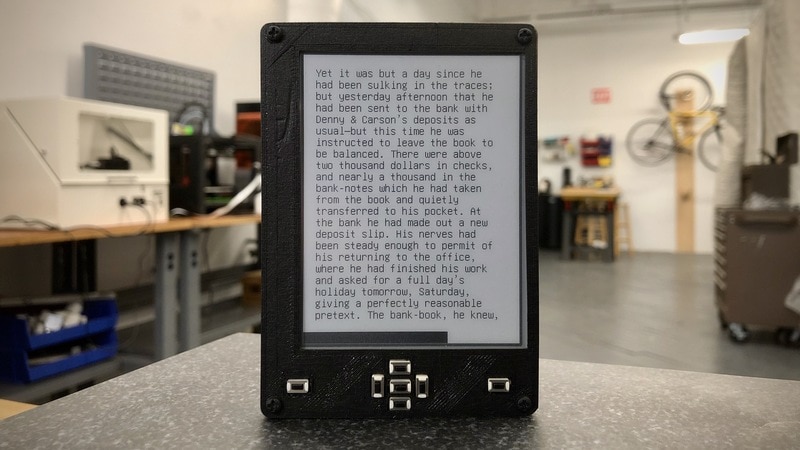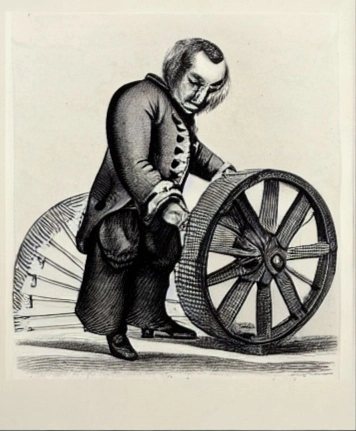IIRC it only suports plain text files / Markdown rn. Not supporting EPUB is a non-starter for me. I use my Kobo right now and love it. If they add EPUB support i will heavily consider building one.
Yeah it’s an interesting project, but it looks bad with the printed case and exposed tact switches, and seems to have little functionality.
The creator is working on an epub-to-text-file converter here:
I’m not sure I understand, epub is both the industry standard and an open format, as far as I know. Why not work on using it or build it around epub from the get-go?
I have to admit I’ll have to wait for the project to start implementing epub to consider getting on board, but it’s still a great effort.
It looks like it is powered by a microcontroller. Maybe it isn’t powerful enough to support epub?
It’s a 120mhz Arm CPU. That’s more than enough for epub. For comparison the 25 Mhz 68030 in the Next computer used Adobe Postcript (PDF) as it’s GUI.
Probably because the computational hardware is not powerful enough to implement a (proto) web browser
It’s a raspberry pi pico. Ebooks could probably work with it on the new version.
It said it’s a 120mhz SAMD51 ARM Cortex-M4.
There’s a version with the pi pico https://github.com/joeycastillo/The-Open-Book
Doesn’t calibre also have a built in converter?
It used to be able to strip DRM from stuff too, but I think they got rid of that for legal reasons.
Yes, Calibre can convert to most formats.
DRM removal is not a feature of Calibre, but of plugins you can add to it. Kobo and Adobe DRM have plugins available. Amazon DRM plugin is in a poor state as Amazon cracked down on a major method earlier this year.
Think I did it that way for some books.
I also seem to remember there being another workaround, by exporting it to my old sony e-reader via the official sony app, which is so old it doesn’t have proper DRM, but I did have to sign up for adobe digital editions or some or other BS. Something like that. End result was a DRM free epub.
Huge waste of time, especially for something I’d paid full price for, so after that I gave up on buying ebooks, and simply pirated them.
Just like with DVDs back in the day and streaming now, you get a shittier experience if you pay full price. Better to pirate.
Calibre already does this but cool we have options.
Epub to text is very easy and Pandoc can do it. I end up using lynx -dump because that’s faster though.
Technically, epub is basically a wepage and thus everything but easy.
You could just strip out the content with a big regex. Surely nothing could go wrong with ̴̬̮̳͔̬̹͖̩͍̄̈̓̀͋̀̎̊̈́̑͛͊̕t̶̘͇̺̠̗̓̿̆̓͋͗́͑͆̈́̈́͊̉̈̍̚ͅḥ̷̡̛͓̹͕̞͎̃͂̽͠ͅã̸͈̟̩̫̪̣̳̜̑̈́̓͗͘t̴̡̮̹͌́̄̔̂́̒͑͘.
You can unzip an epub and find out. Ive done it a couple of times to remove some images from books.
unzip book.epubLast time someone told me I could find out if I would just unzip it didn’t go so well…
deleted by creator
The extremely tiny screen is the deal-breaker for me, I want to build one of these for my father to replace the over a decade old kindle he uses, but I want to upgrade to a bigger screen.
We can’t afford much, and we have a 3d printer and I know my way around a Pi and wiring, so it would be a great option.
But such tiny display for what should be an upgrade from the tech of 10+ years ago :-(
The problem is that such open hardware projects can mostly only work with the components on the market, and eInk displays (or advanced displays in general) are principally only sold by their manufacturers to the OEMs they have contracts with. We are lucky to have any eInk display available to us at all for these kinds of endeavours!
This, plus making bigger eink displays with reasonable refresh and antighosting is a pain. They are proportionately more expensive.
Except I’m dead certain you can buy screens a lot larger than 4.2 inches - the 6 inch screen behind the Kobo Clara HD is actually all over AliExpress and eBay, and it has a backlight and is not marketed for as a replacement for the eReader. Kobo just glues a thin metal plate and a battery to it for rigidity, but otherwise it’s identical. And there are a fair number of other screens you can find online in various sizes if you want to get them working.
The hard part is getting data sheets or reverse engineering them. But it’s far from impossible.
Aren’t all e-readers tiny? I want an A4 sized one (with a stylus for taking notes and scribbling).
There are A4 e-readers. Bamboo note for example.
Yes I’ve seen one. Maybe there are more now than when I looked, but at that time there weren’t enough to be able to make a choice as a consumer.
Onyx Boox has the Note Air 3(10in) and the Tab X(13in). They aren’t cheap though, $400 and $900 respectively, mostly because of how expensive those large eInk screens are.
Well an A4 is over 14" diagonally. A 13" might do but 10" doesn’t qualify imo. And yeah the one I saw was stupid expensive.
Inkplate 10 is not tiny (10"). I’d prefer larger but it’s a start, and fairly affordable. I might get one sometime.
This is an interesting concept but doesn’t seem like it has long term legs.
It depends on what you mean by open source and also even eBook reader (I’m assuming eInk), but if people want open source e-readers I would say flashing existing reader hardware with open source operating systems would be the way to go. However I’m not sure if there is much motivation to do that.
There are Android based eink ereaders available with more freedom than Kindle devices (Boox is an example) and you can side load free or open source reader software onto Kobo (maybe not Android Kindles though?), and you can load free books onto e-readers via software like Calibre. So you can read books in privacy outside the vendors ecosystem - it kinda reduces the imputus to build an open source ereader (hardware or OS).
I’d love to see a truly open source Eink device - particularly software wise. But I doubt the demand is enough. And this Open Source hardware solution seems a bit too cut back to fit the bill.
https://www.pine64.org/pinenote/
It’s not cheap, though.
Removed by mod
A few years ago amazon made a few big screen kindles before settling on the current format, I don’t know which eink screens sizes are available for consumers, but it would be interesting bring that back
A screen around 10" is perfect for reading pdfs. No need to reflow or anything, just read the pdf as it is.
personally I use a 10 inch tablet for pdfs, reading PDFs on eink is a terrible experience.
PDFs are also often reference materials that require flipping back and forth. which makes it doubly painful.
This looks fun. I got a Kobo. I wish it was opensource. It would be cool if some people were to team up with Fairphone and make a Fairbook project to make a light weight device with USB-C charging and long lasting battery life. There needs to be a bigger incentive if the firmware is ever going to get better. You could just use Linux as per usual tho.
That would be great!
I also have a Kobo, Calibre works great with it (Calibre is a life saver) but it would be nice to get something that is more open.
I would love a full kit for the open book. Or a preassembled one. I just don’t have the time anymore to solder/assemble it but I would pay a good amount for the open book.
I feel that. I desperately want to support open source hardware, but don’t have the chops to do it from scratch.
Framework laptops been close to that dream though.
Pocketbook anyone?
Love my Era
Here!
To add, the used linux kernel of PB devices is mostly open source last time I checked.
I’m glad to see some other options. I’m not a fan of Amazon, but the only other practical option has been tablets, which are generally a lot more expensive and less well-suited to the purpose. This looks like a good design.
Kobo and Boox are both great alternatives to Kindles.
The first couple of Kobos I got over the last decade were admittedly a bit shit and plasticky, but I stuck with them, and the one I have now was double the price and ten times the quality. Really good company now
To add more context to this, this literally happened yesterday, but I bought a Kobo Touch (the N905 from 2011) new in box with a receipt from every it was purchased a week after launch in July 2011. I took it out of the box, plugged it into my computer to charge, and once it had some juice I followed the onscreen setup and it just works. It was discontinued 8 years ago but the links and setup instructions are still active and functioning. It doesn’t really feel any cheaper than my Paperwhite from 2017, and it reads epubs natively unlike the Paperwhite, so should be just fine for my daughter
I wasn’t impressed with the Kobo, although it does the job. I’m not familiar with the Boox. I will have to look that one up.
What sets some of Boox’s models apart from the other e-readers is they’re full Android devices; you can install most apps from the Play Store. Perhaps not as great for battery life, but a world apart so far as functionality goes (and you can even install the other e-book vendors’ apps if you have existing purchased content).
In the “pocketable” size category, Palma which is a phone form-factor device (I have one of these, has been great), the Page looks very much inspired by the design of the Kindle Oasis, or the Tab Mini C has a colour e-ink display.
There are other ebook readers. What’s up with those?
Same. I’m waiting with baited breath. I feel like I’m the target market for this: I love my e-reader, I love open source stuff, and I hate the options on the market. Sadly, my experience is that these things can’t compete on the economy of scale, and are often at least 50% more expensive than the alternative. I want to vote with my dollars, but I’m not rich, and used e-readers are always on eBay & Craigslist for $40.
We’ll see, though.
What’s wrong with the barbs n noble one?
Kinda basic for the price, and the built-in store is the B&N Store. But they at least have EPUB and PDF support, and Adobe DRM compatibility, so you can hook them up to a PC and transfer books.
They do run a stripped down Android underneath, so you might be able to Root them and install a third-party launcher and apps on it, I’ve done this in the past, but I haven’t kept up in recent years(I’ve switched to Boox devices) so it might not be as easy to Root these days.
Barbs n noble
Haha, autoincorrect has a sense of humor!
Aren’t those just kindles? I don’t remember for sure.
Edit: Wait, they’re Amazon Fire tablets I think.
Ah hell, I don’t remember, just know they’re a mainstream, relabled device.
There are tons of options out there other than Amazon. I just upgraded my original Kindle Paperwhite to a Onyx Boox Page. Paid the same amount as a Kindle Oasis (at least when it isn’t on sale), but since it supports Android apps it has so many more uses.
Really cool! I do wish the screen was a bit bigger. It’s the size of my 2012 windows phone, haha.
I’ve got a Hisense A5 and reading is surprisingly nice on it. Although this looks even smaller?
Also regarding the overall idea - just get a Kobo and put Koreader on it, then sideload any book format you like.
I do have a kobo! It’s pretty good. What’s Koreader? Is that software to jailbreak it?
Yeah, you don’t even have to jailbreak it, you can just install it alongside the kobo software, then you can keep both. It’s a bit fiddly to set up but not too bad https://github.com/koreader/koreader/wiki/Installation-on-Kobo-devices
Koreader is available from the Play store if you have an android phone, you can try it out first. Its very customisable, I spend hours tweaking the settings because that’s my idea of fun 😂
Thank you! Saving this post :)
deleted by creator
“When it comes to an eBook reader, the choices are limited.”
?
Limited to every other smart phone and tablet on the planet?
Having a good, dedicated e-reader is a hill that I would die on. I want a big screen, with physical buttons, lightweight, multi-weeklong battery, and an e-ink display. Reading 8 hours on my phone makes my eyes go twitchy. And TBH it’s been a pain finding something that supports all that and has a reasonably open ecosystem.
When reading for pleasure, I’m not gonna settle for a “good enough” experience. Otherwise I’m going back to paper books.
I don’t buy the need for e-ink. I’m on normal LCDs for… way more hours than I’d care to admit. No strain.
Have you used an e-ink reader? The difference is remarkable. My Kobo battery died this morning, so I finished the book I was reading on my iPad, which was fine, but much less pleasant.
Besides, it’s not just about the screen. The lack of distractions in a device that serves only one purpose is just as important to me.
I’ve looked at e-ink readers multiple times since they first came out and they are all garbage. Low resolution, trash images, garbage refresh rates, slow page turns, awful white levels.
I literally see no reason to ever use one over a nice phone or tablet display which, by the way, can be used for other content options besides text.
Did you not see the bit about not actually wanting other content options? My Kobo is a single use device that is incredible at what I want it to do. I don’t care about refresh rates or resolution, literally all I care about is that it displays text comfortably without being glaring. And it does that.
So does my phone and tablet and laptop.
Ok buddy.
Congrats. You won the genetic lottery and was awarded some top tier eyes.
A lot of people were not.
OOT but after 12 years being the only person without glasses in my family, I’m getting my glasses this week :(
Disagree completely. I’m on LCD for hours as well, but reading on E-Ink is so much more convenient
Feels like maybe you’re not the target audience for this article
They’re complaining about refresh rates and images, so I’m thinking they aren’t. I’m waiting for ‘you can’t watch a video on them!’























